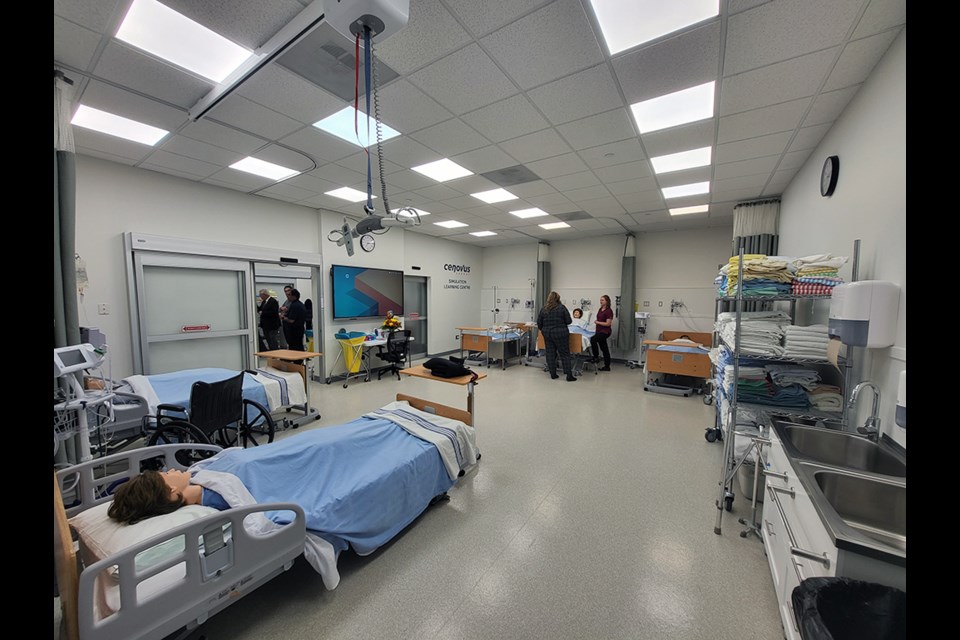North West College held the official grand opening for the newly renovated Cenovus Energy Learning Simulation Centre Dec. 15.
The ribbon cutting in front of the Cenovus Energy logo, with Dr. Eli Ahlquist, CEO and president of the college; George Prudat, chair of the board of governors; and Glen Hemmelgarn, operations superintendent for Cenovus Energy, pictured with students of the NWC.
The high-fidelity simulation testing room uses an advanced simulation mannequin that mirrors a living patient, using an attached computer to speak and react to the student. The student can feel a pulse, read the patient’s blood pressure, measure heart rates and listen to bowel sounds. Depending on the care provided, the mannequin can deteriorate, improve or be used to test a team of nurses’ response to a code called.
Live demonstrations were held, with a demonstration of the lift used to transfer patients on display.
A student demonstrates the proper procedures for putting on gloves before working with a patient.
A student demonstrates the process of inserting a feeding tube into a patient.
Dr. Eli Ahlquist, CEO and president of the college spoke at the opening ceremony, along with other dignitaries and guests.
North West College unveils new state of the art simulation centre
By Miguel Fenrich
Staff Reporter
NORTH BATTLEFORD — Following continued demand for North West College’s nursing programs in the Battlefords, the college has been working for over a year to expand the campus’s current simulation learning centre to meet the needs of the 120 students engaged in the nursing programs at the college.
On Dec. 15, the college held its grand opening and ceremony for the newly improved, state-of-the-art Cenovus Energy Learning Simulation Learning Centre. It expands from four beds to 10 and includes a high-fidelity simulation testing room.
The facility is fully immersive, allowing students to test their skills and use their theories in real-life scenarios.
Through these experiences, the college aims to enhance the education of students and elevate the next generation of health care professionals in Saskatchewan.
“The students have been absolutely overjoyed with the new space. It’s fantastic to have that large environment where they can spread out and learn,” Dr. Eli Ahlquist, CEO and president of the college, said.
“... we have modern equipment, and it looks just like a hospital. We’ve equipped (the centre) with compressors to provide simulated oxygen and other elements so they truly engage all of those skills,” Ahlquist said.
The college was able to secure funding from the Saskatchewan government to support construction, with Cenovus Energy donating $50,000 to purchase equipment and supplies to outfit the centre.
The centre allows students to apply their skills in a fully immersive environment to ensure they’re capable of going into hospitals and other health centres.
“It is about the quality of graduates we can produce. We’re quite proud that in the Battlefords, students will get an identical education to what they receive in Saskatoon and Regina.
“That’s important to the Battlefords, because it allows students to live and learn in their home community. Our goal is to educate local so that they stay local and are able to support the local hospitals and be able to provide necessary skills,” Ahlquist said at the centre's grand opening.
The grand opening began with greetings from Dr. Priscilla Lothian, vice-president for the college; George Prudat, chair of the board of governors; Jeremy Cockrill (MLA for the Battlefords); and Glen Hemmelgarn, operations superintendent for Cenovus Energy.
Speaking for Cenovus, Hemmelgarn said that the company likes to be a part of the community. Because their operators live in these communities, they feel it’s essential to build strong, resilient communities while supporting strong health care workers and education.
“As a company, we can support a facility like this because it supports the education, which not only then provides the community with the health care workers that our operators will use in the future, but it helps to build the community further,” Hemmelgarn said.




